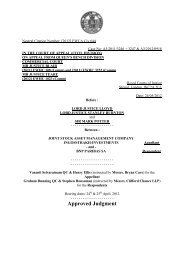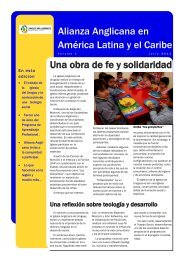TRUSTS OF LAND AND PROPRIETARY ESTOPPEL ... - Support
TRUSTS OF LAND AND PROPRIETARY ESTOPPEL ... - Support
TRUSTS OF LAND AND PROPRIETARY ESTOPPEL ... - Support
You also want an ePaper? Increase the reach of your titles
YUMPU automatically turns print PDFs into web optimized ePapers that Google loves.
(2) where there was no evidence of actual agreement, by inference from theconduct of the parties in relation to the property (as to both the commonintention, reliance and detriment), readily justified where B contributesdirectly to the purchase price, whether by cash contribution or itsequivalent, or by paying mortgage instalments 18 ;15. However, Lord Bridge’s doubt that anything less than a contribution to thepurchase price will do to infer a common intention was in itself doubted in Stackv Dowden, where Baroness Hale suggested that his “the observations, which werestrictly obita dicta, … have set [the first] hurdle rather too high in certain respects.” 19 . LordWalker also commented that the law had moved on 20 , a position more firmlyadopted by Baroness Hale in Abbott v Abbott, where she considered that:“The Court of Appeal appears to have attached undue significance to the dictum ofLord Bridge …, in particular as to what conduct is to be taken into account inquantifying an acknowledged beneficial interest. The law has indeed moved on since then.The parties' whole course of conduct in relation to the property must be taken intoaccount in determining their shared intentions as to its ownership.” 2116. The authors of the latest edition of Megarry & Wade, The Law of Real Property andthe Court in Holman v Howes 22 and Hapeshi v Allnatt 23 have all adopted thisbroader approach.17. This has not met universal support however, and a number of recent decisionshave cautioned against inferring a common intention from conduct alone,particularly of domestic duties, staying home to look after the children,contribution to rates and certain utility bills and purchase of some fittings andfixtures and domestic chattels 24 .18 In the earlier case of Grant v Edwards [1986] Ch 638 it had been said that contributions to the purchaseprice of the property will show evidence from which an intention can be inferred, as corroboration ofdirect evidence of intention, as evidence that the Claimant has acted to her detriment in reliance on theintention, and to quantify the size of her beneficial interest.19 Para [63]20 Para [26]21 Para [19].22 [2007] EWCA Civ 877. Although in that case the parties had agreed that the wife had a beneficial interest,so the question was one of quantification only, the second hurdle.23 [2010] EWHC 392 at para [18]24 See Morris v Morris [2008] EWCA Civ 257 per Sir Peter Gibson at para [23]; Thompson v Humphrey[2009] EWHC 3576 (Ch) per Warren J at Para [29]; and Jones v Kernott [2009] EWHC 1713 per5


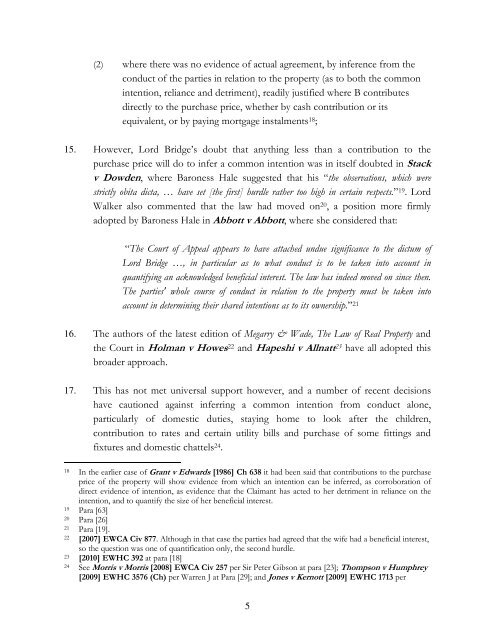
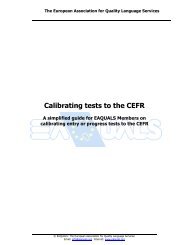
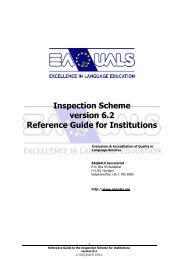
![[2012] UKUT 399 (TCC)](https://img.yumpu.com/51352289/1/184x260/2012-ukut-399-tcc.jpg?quality=85)

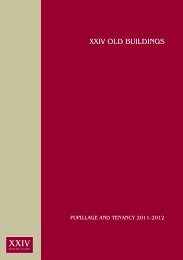
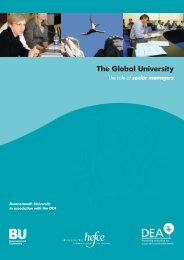

![Neutral Citation Number: [2009] EWHC 3198 (Ch) Case No: CH ...](https://img.yumpu.com/50120201/1/184x260/neutral-citation-number-2009-ewhc-3198-ch-case-no-ch-.jpg?quality=85)
